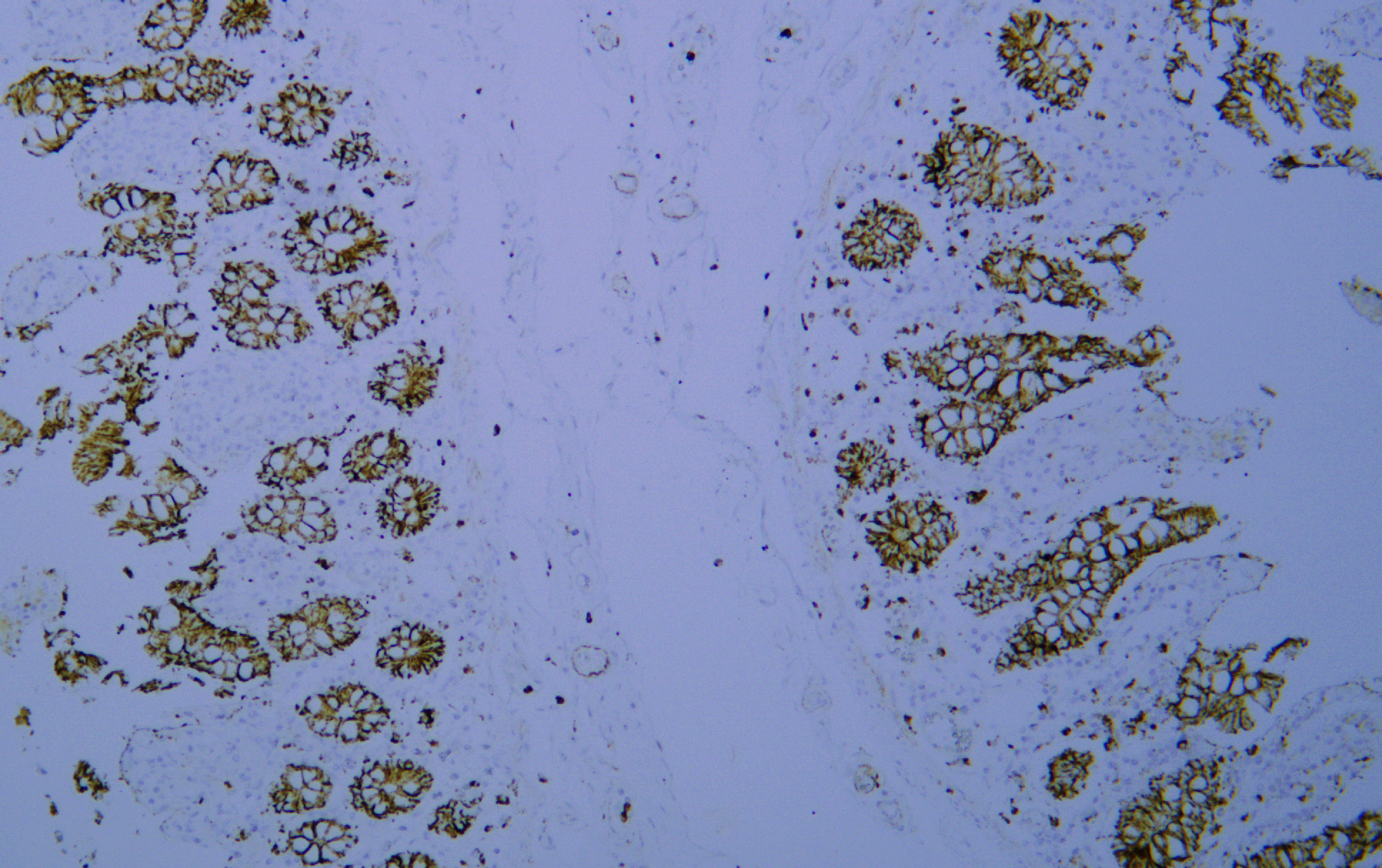
Catalog: YM6100
Size
Price
Status
Qty.
200μL
$600.00
In stock
0
100μL
$340.00
In stock
0
40μL
$190.00
In stock
0
Add to cart


Collected


Collect
Main Information
Target
TGF β Receptor I
Host Species
Mouse
Reactivity
Human, Mouse, Rat, Bovin,
Applications
IHC, IF, ELISA
MW
55kD (Calculated)
55kD (Observed)
Conjugate/Modification
Unmodified
Detailed Information
Recommended Dilution Ratio
IHC 1:50-200; IF 1:50-200; ELISA 1:500-5000
Formulation
PBS, 50% glycerol, 0.05% Proclin 300, 0.05%BSA
Specificity
This antibody detects endogenous levels of TGF β Receptor I protein.
Purification
The antibody was affinity-purified from ascites by affinity-chromatography using specific immunogen.
Storage
-15°C to -25°C/1 year(Do not lower than -25°C)
MW(Calculated)
55kD
MW(Observed)
55kD
Modification
Unmodified
Clonality
Monoclonal
Clone Number
ABT-TGFR1
Isotype
IgG2a,Kappa
Related Products
Antigen&Target Information
Immunogen:
Synthesized peptide derived from human TGF β Receptor I AA range: 34-100
show all
Specificity:
This antibody detects endogenous levels of TGF β Receptor I protein.
show all
Gene Name:
TGFBR1 ALK5 SKR4
show all
Protein Name:
TGF-beta receptor type-1 (TGFR-1) (Activin A receptor type II-like protein kinase of 53kD) (Activin receptor-like kinase 5) (ALK-5) (ALK5) (Serine/threonine-protein kinase receptor R4) (SKR4) (TGF-beta type I receptor) (Transforming growth factor-beta receptor type I) (TGF-beta receptor type I) (TbetaR-I)
show all
Background:
The protein encoded by this gene forms a heteromeric complex with type II TGF-beta receptors when bound to TGF-beta, transducing the TGF-beta signal from the cell surface to the cytoplasm. The encoded protein is a serine/threonine protein kinase. Mutations in this gene have been associated with Loeys-Dietz aortic aneurysm syndrome (LDAS). Multiple transcript variants encoding different isoforms have been found for this gene. [provided by RefSeq, Aug 2008],
show all
Function:
Catalytic activity:ATP + [receptor-protein] = ADP + [receptor-protein] phosphate.,cofactor:Magnesium or manganese.,Disease:Defects in TGFBR1 are the cause of aortic aneurysm familial thoracic type 5 (AAT5) [MIM:608967]. Aneurysms and dissections of the aorta usually result from degenerative changes in the aortic wall. Thoracic aortic aneurysms and dissections are primarily associated with a characteristic histologic appearance known as 'medial necrosis' in which there is degeneration and fragmentation of elastic fibers, loss of smooth muscle cells, and an accumulation of basophilic ground substance.,Disease:Defects in TGFBR1 are the cause of Loeys-Dietz syndrome type 1A (LDS1A) [MIM:609192]; also known as Furlong syndrome or Loeys-Dietz aortic aneurysm syndrome (LDAS). LDS1 is an aortic aneurysm syndrome with widespread systemic involvement. The disorder is characterized by arterial tortuosity and aneurysms, craniosynostosis, hypertelorism, and bifid uvula or cleft palate. Other findings include exotropy, micrognathia and retrognathia, structural brain abnormalities, intellectual deficit, congenital heart disease, translucent skin, joint hyperlaxity and aneurysm with dissection throughout the arterial tree.,Disease:Defects in TGFBR1 are the cause of Loeys-Dietz syndrome type 2A (LDS2A) [MIM:608967]. LDS2 is an aortic aneurysm syndrome with widespread systemic involvement. Physical findings include prominent joint laxity, easy bruising, wide and atrophic scars, velvety and translucent skin with easily visible veins, spontaneous rupture of the spleen or bowel, diffuse arterial aneurysms and dissections, and catastrophic complications of pregnancy, including rupture of the gravid uterus and the arteries, either during pregnancy or in the immediate postpartum period. LDS2 is characterized by the absence of craniofacial abnormalities with the exception of bifid uvula that can be present in some patients.,Function:On ligand binding, forms a receptor complex consisting of two type II and two type I transmembrane serine/threonine kinases. Type II receptors phosphorylate and activate type I receptors which autophosphorylate, then bind and activate SMAD transcriptional regulators. Receptor for TGF-beta.,PTM:Phosphorylated at basal levels in the absence of ligand binding. Activated by multiple phosphorylation, mainly in the GS region.,similarity:Belongs to the protein kinase superfamily.,similarity:Belongs to the protein kinase superfamily. TKL Ser/Thr protein kinase family. TGFB receptor subfamily.,similarity:Contains 1 GS domain.,similarity:Contains 1 protein kinase domain.,subunit:Interacts with CD109. The unphosphorylated protein interacts with FKBP1A and is stabilized the inactive conformation. Phosphorylation of the GS region abrogates FKBP1A binding. Interacts with SMAD2 when phosphorylated on several residues in the GS region.,tissue specificity:Found in all tissues examined, most abundant in placenta and least abundant in brain and heart.,
show all
Cellular Localization:
Membranous
show all
Tissue Expression:
Research Areas:
>>MAPK signaling pathway ;
>>Cytokine-cytokine receptor interaction ;
>>FoxO signaling pathway ;
>>Endocytosis ;
>>Cellular senescence ;
>>TGF-beta signaling pathway ;
>>Apelin signaling pathway ;
>>Osteoclast differentiation ;
>>Hippo signaling pathway ;
>>Adherens junction ;
>>Th17 cell differentiation ;
>>Relaxin signaling pathway ;
>>AGE-RAGE signaling pathway in diabetic complications ;
>>Chagas disease ;
>>Hepatitis B ;
>>Human T-cell leukemia virus 1 infection ;
>>Pathways in cancer ;
>>Colorectal cancer ;
>>Pancreatic cancer ;
>>Chronic myeloid leukemia ;
>>Hepatocellular carcinoma ;
>>Gastric cancer ;
>>Diabetic cardiomyopathy
>>Cytokine-cytokine receptor interaction ;
>>FoxO signaling pathway ;
>>Endocytosis ;
>>Cellular senescence ;
>>TGF-beta signaling pathway ;
>>Apelin signaling pathway ;
>>Osteoclast differentiation ;
>>Hippo signaling pathway ;
>>Adherens junction ;
>>Th17 cell differentiation ;
>>Relaxin signaling pathway ;
>>AGE-RAGE signaling pathway in diabetic complications ;
>>Chagas disease ;
>>Hepatitis B ;
>>Human T-cell leukemia virus 1 infection ;
>>Pathways in cancer ;
>>Colorectal cancer ;
>>Pancreatic cancer ;
>>Chronic myeloid leukemia ;
>>Hepatocellular carcinoma ;
>>Gastric cancer ;
>>Diabetic cardiomyopathy
show all
Signaling Pathway
Cellular Processes >> Cell growth and death >> Cellular senescence
Cellular Processes >> Cellular community - eukaryotes >> Adherens junction
Organismal Systems >> Immune system >> Th17 cell differentiation
Organismal Systems >> Endocrine system >> Relaxin signaling pathway
Organismal Systems >> Development and regeneration >> Osteoclast differentiation
Human Diseases >> Cancer: overview >> Pathways in cancer
Human Diseases >> Cancer: specific types >> Colorectal cancer
Human Diseases >> Cancer: specific types >> Pancreatic cancer
Human Diseases >> Cancer: specific types >> Hepatocellular carcinoma
Human Diseases >> Cancer: specific types >> Gastric cancer
Human Diseases >> Cancer: specific types >> Chronic myeloid leukemia
Environmental Information Processing >> Signal transduction >> MAPK signaling pathway
Environmental Information Processing >> Signal transduction >> TGF-beta signaling pathway
Environmental Information Processing >> Signal transduction >> Hippo signaling pathway
Environmental Information Processing >> Signal transduction >> Apelin signaling pathway
Environmental Information Processing >> Signal transduction >> FoxO signaling pathway
Environmental Information Processing >> Signaling molecules and interaction >> Cytokine-cytokine receptor interaction
Reference Citation({{totalcount}})
Catalog: YM6100
Size
Price
Status
Qty.
200μL
$600.00
In stock
0
100μL
$340.00
In stock
0
40μL
$190.00
In stock
0
Add to cart


Collected


Collect
Recently Viewed Products
Clear allPRODUCTS
CUSTOMIZED
ABOUT US
Toggle night Mode
{{pinfoXq.title || ''}}
Catalog: {{pinfoXq.catalog || ''}}
Filter:
All
{{item.name}}
{{pinfo.title}}
-{{pinfo.catalog}}
Main Information
Target
{{pinfo.target}}
Reactivity
{{pinfo.react}}
Applications
{{pinfo.applicat}}
Conjugate/Modification
{{pinfo.coupling}}/{{pinfo.modific}}
MW (kDa)
{{pinfo.mwcalc}}
Host Species
{{pinfo.hostspec}}
Isotype
{{pinfo.isotype}}
Product {{index}}/{{pcount}}
Prev
Next
{{pvTitle}}
Scroll wheel zooms the picture
{{pvDescr}}








poly-ihc-rat-kidney.jpg)












